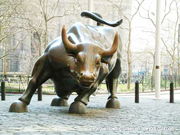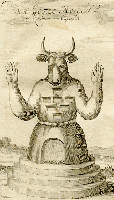Wall Street is the heart that pumps millions of dollars into the arteries of New York. And yet, the area where it is located, the Financial District, is quite unremarkable if you see it from the outside. Big, gray office buildings, fast food stores and people swarming the streets from Monday through Friday.
Thankfully, it has a God: a bull made of bronze that nobody asked for and that has stayed there out of mere happenstance. He symbolizes the sacrifices that a hunger for gold demands. Thus, we shall call him Moloch.
Moloch's creator, Arturo Di Mola, was a sculptor that needed some publicity. So he dumped the three-ton metallic bull at the doors of the NYSE (New York stock exchange) one morning of 1989. The stunt was liked in City Hall and so they decided to put the bull at the entrance of the Financial District.

This beast, perennially charging towards the sky, is a symbol of the market itself. When the market is bullish, stocks go up and everything is fine. When stock goes down, things go bearish, like the animal that stoops towards the ground. If you see it, you will notice the bull's head is shinier than the rest of his body. That is because every morning, as people head to work at the NYSE, they rub its head and its horns hoping it will bring them good luck.
Such a recent and fortuitous image has come to embody New York. Let's echo for a minute the reasoning a Spanish reporter once did -- a correspndant in New York, he reasoned that the bull in question resembles Moloch, the evil Canaanite god who demanded gold and sacrifices from his people. But this is a new incarnation of Moloch. A contemporary one. We shall follow that reporter's reasoning for the rest of the section. Starting with Allen Ginsberg, who would refer to it in his poem Howl:
Moloch whose eyes are a thousand blind windows!
Moloch whose skyscrapers stand in the long
streets like endless Jehovahs! Moloch whose fac-
tories dream and croak in the fog! Moloch whose
smokestacks and antennae crown the cities!
"Most Americans," said this reporter "think that Moloch rules New York. And a lot of them don't like it. The American civilization has become pro-suburbs and anti-city. New York, to them, is ascribed with a kind of indelible foulness, some kind of original sin which contrasts with the Christian purity of the City Upon a Hill, the country's foundational myth."
Maybe it is because the U.S. still hasn't gotten over the archipelago's Dutch origins, its religious tolerance (or indifference) or its lax ways.
Anyway, the city is the way it is because it is the heart of capitalism. And it is the heart of capitalism because it is the way it is. A liberal, brutally honest city with just enough ideals to get by and a selfishness which some people appreciate and others don't. And it is thanks to its six foundational divinities. Six men who shaped the city -- not only physically, which is more or less easy, but also psychologically.

Except for one, they all died in the 20th century. They are recent deaths. And yet, they are relatively obscure figures. New Yorkers don't necessarily know about them. They are myths, legends, origin stories. Like apostles in a new New Testament.
They enjoyed the economic boom of the era after the Civil War, the astounding discovery of America's inherent riches and the impotence of its public powers.
They were immortalized in stone, in multinationals, in institutions, in collections of art.
Not unlike Yahve in the Pentateuch, they were cruel and monopolistic. They moved mountains, dictated commandments, annihilated their enemies, caused great afflictions and massacres. But they made New York the new Promised Land.
They are as follows:
The laws they created are still intact. They are the six divinities that made New York. The six heads of Moloch.